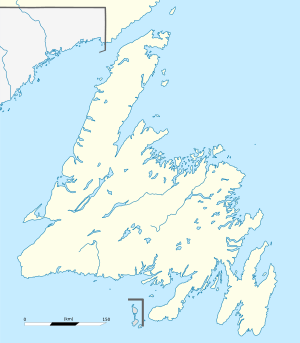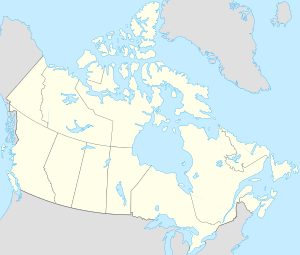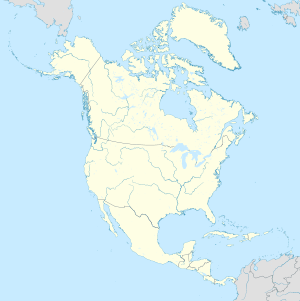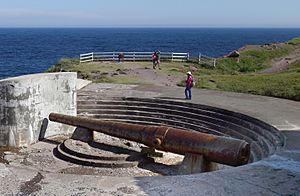Cape Spear facts for kids
Quick facts for kids Cape Spear |
|||
|---|---|---|---|
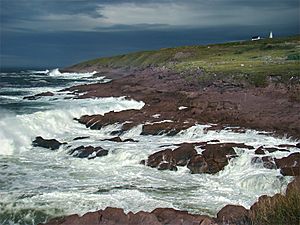 |
|||
| Location | Newfoundland, Canada | ||
| Coordinates | 47°31′25″N 52°37′10″W / 47.52361°N 52.61944°W | ||
| Elevation | 75 metres (246 ft) | ||
|
|||
Cape Spear (French: Cap d'Espoir) is a headland on the Avalon Peninsula of Newfoundland. It is located near St. John's in the Canadian province of Newfoundland and Labrador.
This cape is the easternmost point in Canada and North America. Only Greenland is further east. Cape Spear is about 12 kilometres (7.5 miles) from downtown St. John's.
The Portuguese people first named this place Cabo da Esperança. This means "cape of hope." Later, it became Cap d'Espoir in French. Finally, it was called "Cape Spear."
Cape Spear is also a starting or ending point for two parts of the East Coast Trail.
Contents
Cape Spear's Past
Long ago, the Cape Spear area was home to the Beothuk people. Mi'kmaq communities also visited the area. They gathered food and resources temporarily. This was before they settled in places like St. George's Bay.
European settlers saw Cape Spear as a very important place. It was the easternmost point in Canada. However, there is no sign that Indigenous groups saw it this way. They did not think of it as a "land's end" that was special to them.
World War II Defenses
During the Second World War, Cape Spear was very important. It was close to the routes ships took to deliver supplies. To protect the entrance to St. John's harbour, a gun battery was built here.
This battery had two large 10-inch guns. They were placed on special mounts that could hide them. Soldiers lived in barracks and used underground passages. These passages led to bunkers. The big gun barrels are still there today. The bunkers offer a safe place to view the ocean.
Lighthouses of Cape Spear
A lighthouse has been working at Cape Spear since September 1836. This first lighthouse was the second one built in Newfoundland. The very first was built in 1810 at Fort Amherst, St. John's. That one was at the entrance to St. John's Harbour.
In 1832, a group was formed to build lighthouses. Cape Spear was chosen for a new lighthouse. It was on the rocky eastern coast, close to St. John's harbour.
Nicholas Croke and William Parker built the first lighthouse. Work started in 1834 or 1835. It was a square wooden building. A tower in the middle held the light. A foghorn was added in 1878 to help ships in foggy weather.
The first light used at Cape Spear came from Scotland. It had been used there since 1815. This light used seven special lamps and curved reflectors. Later, a modern lens system was used. The light first ran on oil, then acetylene, and finally electricity in 1930.
A new concrete lighthouse was built in 1955. The original light from the old building was moved into this new one.
Lighthouse Keepers
In 1835, a warship with an important visitor got lost in thick fog. A young harbour pilot named James Cantwell found the ship. He guided it safely into the harbour. When asked what reward he wanted, he asked to be the keeper of the Cape Spear lighthouse.
The job had been promised to another man, Emmanuel Warre. But when Warre died ten years later, James Cantwell became the second keeper. He worked there for 35 years. His son Dennis later took over. The Cantwell family kept the Cape Spear light for over 150 years!
| Name | Years |
|---|---|
| Emanuel Warre | 1836–1846 |
| James Cantwell | 1846–1879 |
| Austin Oke Sheppard | 1880–1886 |
| Dennis Cantwell | 1886–1909 |
| James Cantwell | 1909–1918 |
| William Cantwell | 1918–1925 |
| Jack Cantwell | 1925–1939 |
| Weston Cantwell | 1939–1944 |
| Frank Cantwell | 1944–1965 |
| Martin Hefferan | 1965–1982 |
| Gerald Cantwell | 1982–1997 |
A National Historic Site
The original Cape Spear lighthouse is the oldest lighthouse still standing in Newfoundland. Because of its history, it has been named a National Historic Site of Canada.
The old lighthouse building and the lightkeeper's home have been fixed up. They now look like they did in 1839. You can visit them and learn about the past. There is also a gift shop for visitors. The lighthouse was officially protected in June 2016.
Cape Spear has beautiful views and interesting history. But the waves can be very large and unpredictable. Parks Canada has put up many warning signs. This is to keep visitors safe from the powerful ocean waves.
See also
 In Spanish: Cabo Spear para niños
In Spanish: Cabo Spear para niños


